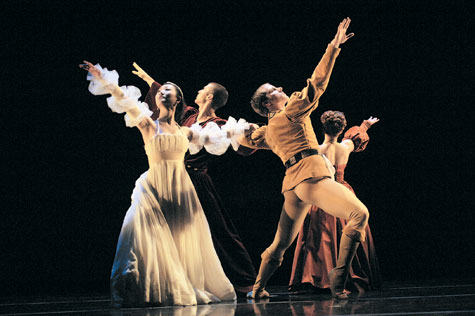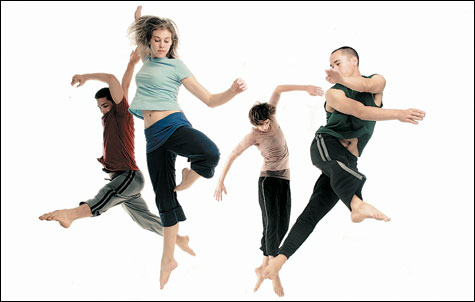
THE MOOR’S PAVANE Set to music of Henry Purcell, José Limón’s work reconsiders Shakespeare’s doomed Othello, Iago, Desdemona, and Emilia. |
One thing that distinguishes the early modern dancers from their contemporary descendants is idealism, or the lack of it. Back to back last weekend, we got the noble archetypes of José Limón and Martha Graham in revivals at Boston Conservatory and the work of Doug Varone, where dancing could be as ordinary as brushing your teeth, at the Institute of Contemporary Art. At both ends of this 80-year history, choreography starts with abstraction — a gesture, a character, a word — that filters out through the body's resources till it's no longer literally evident. The movement then contains both the imaginative physical possibilities and the DNA of the idea. Think Picasso's guitars.
Graham's Lamentation (1930) is among the purest dance examples of this. Directed by Graham stalwart Yuriko, assisted by Susan Kikuchi, and danced by Laura McNeill on Thursday night, Lamentation doesn't depict grief. Instead, it creates a monolithic impression that's hardly connected to a person. Encased except for her face and hands in a tube of dark material, a woman sits on a bench. She rocks back and bends forward. She tilts to the side, pulled off balance by an elbow. She plunges her fists into the abyss between her knees. She reaches out, but the shell of material confines her pent-up energy. Two quick spasms from deep inside make the whole sheath shudder. After scarcely five minutes, she folds over, pulling the cloth over herself like a blanket, a shroud.
Five years later, in Frontier, Graham had left the cocoon and entered a more forthright Americana phase. But she was still scouring away everything to get to the core of a character. In this miniature, the life of an iconic pioneer woman is compressed into a brief dance rondo. The woman leans against a section of a split-rail fence. She moves off it, treading and retracing a squared-off pathway, always facing the audience. On each circuit, she changes her body slightly and adjusts her step. Flashes of exhilaration, apprehension, faith, motherhood. The movement is by turns spare, open, assertive and pensive, like the music written for it by Louis Horst.
Lissa Smith performed it athletically, in a blowsy costume borrowed from Ballet San Jose. I thought both the flowing lines of the dress and the flung-out energies of the dancer worked against the austerity of the choreographic idea. None of Graham's Americana pieces, or for that matter the epic Greek tragedies she choreographed later, was free of Puritan restraint.

“SPILLING THE CONTENTS” Varone’s Chapters from a Broken Novel began at high energy, with the dancers running, falling, rolling, spiraling through the space. |
Conservatory faculty member Jennifer Scanlon reconstructed Limón's masterful The Moor's Pavane (1949), a dance she performed as a member of the Limón company. Set to music of Henry Purcell, the work reconsiders Shakespeare's doomed Othello, Iago, Desdemona, and Emilia. The story is advanced in a series of pairings. The characters confront one another and then return to the courtly civility of a quasi-Renaissance dance. As they become enmeshed in personal intrigue, the dance's formality begins to crumble. Limón told the story of Iago's scheming, Emilia's complicity, Othello's jealousy, and Desdemona's innocence in the most economical terms. Iago plants the seeds of jealousy by whispering in Othello's ear. Emilia disarms Desdemona with flattery, then snatches the dropped handkerchief that will serve as evidence of infidelity.